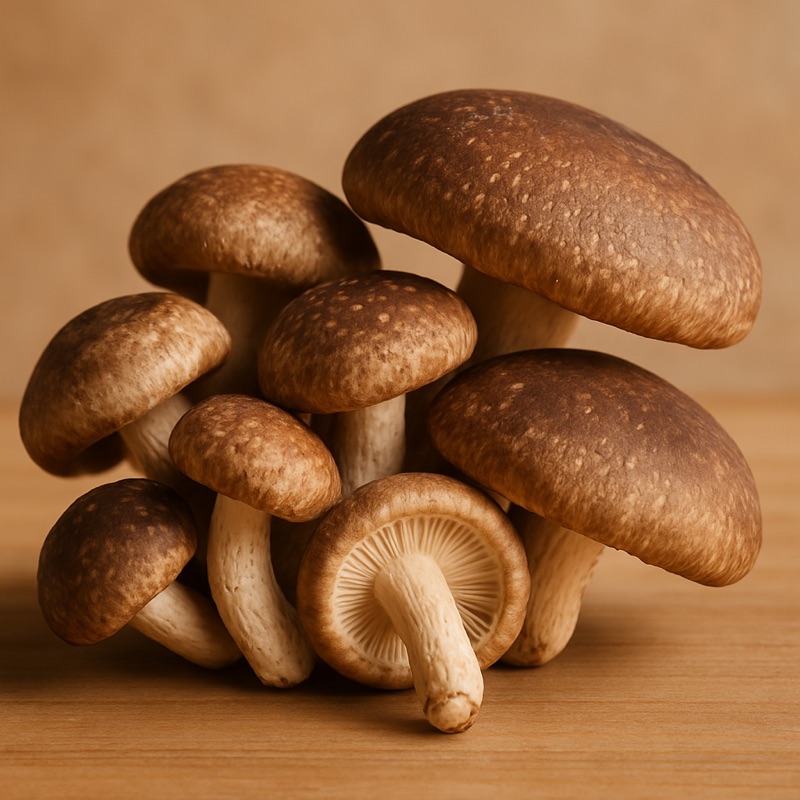Shiitake (Lentinula edodes)
Basic Plant Profile
Botanical Basics
- Common Name(s): Shiitake, Oak Mushroom, Black Forest Mushroom, Chinese Black Mushroom
- Folk Name(s): “Fragrant mushroom” (Chinese: Xiānggū), “Flower shiitake” (Huāgū; cracked-cap grade)
- Scientific/Latin Name: Lentinula edodes (syn. Lentinus edodes)
- Family: Omphalotaceae (Order: Agaricales)
- Plant Type: Saprophytic basidiomycete fungus (wood-decomposer)
- Botanical Description: Medium brown to dark umber cap (typically 5–12 cm) with fine scales; white to cream gills; firm, fibrous stipe; white spore print. Grows in clusters from dead or dying hardwood. Distinct savory aroma.
- Growing Zones/Climate: Best in temperate climates; outdoor log culture is common roughly in USDA Zones 5–9 (can be grown elsewhere with microclimate/shade management). Indoor/sawdust block culture is widely adaptable.
- Best Zones for Growth: Cool, moist woodland conditions; consistent spring/fall fruiting where temps are ~45–75°F (7–24°C).
- Habitat & Range: Native to East Asia; naturally colonizes hardwoods (notably “shii” tree—Castanopsis cuspidata—and oaks). Now cultivated worldwide.
Cultivation & Harvest
- Soil & Sun Requirements: Soil is not used—grown on wood. Needs heavy shade (70–90%) and high humidity during fruiting. Protect from drying winds and direct sun.
- Propagation: Inoculate fresh hardwood logs (oak, beech, sugar maple, sweetgum) with plug or sawdust spawn. Drill 1–1.5 in (2.5–4 cm) deep holes ~6–8 in (15–20 cm) apart in a diamond pattern; fill with spawn and seal with wax. Incubation: ~6–12 months (sometimes up to 18) before first flush. Soaking logs 12–24 hours in cold water can “shock” fruiting. Sawdust blocks: fruit much faster (weeks).
- Companion Planting: N/A (non-plant). Practically, keep logs in shaded beds alongside moisture-holding groundcovers (ferns, hostas) to stabilize humidity; avoid conifer logs and freshly treated wood.
- Harvesting Guidelines: Harvest when caps are 70–90% expanded and edges still slightly rolled. Twist gently or cut at base; avoid tearing the bark/log surface. Expect multiple flushes per year; a good oak log may produce for 3–5 years.
- Drying/Preservation: Slice and dehydrate at low heat (95–115°F / 35–46°C) until fully dry; store airtight. Sun-drying briefly after dehydration (or before) can dramatically boost vitamin D2 (ergosterol → D2). Powder for seasoning; freeze sautéed mushrooms for quick use.
Traditional & Historical Use
- Cultural Significance: Revered for centuries in China and Japan as a delicacy and healthful food; recorded trade and tribute mushroom since at least the Song dynasty. Integral to Japanese, Chinese, and Korean cuisines.
- Traditional Medicine: Used in East Asian traditions as a strengthening food—supporting vitality, digestion, and resilience. In modern Japanese medicine, purified lentinan (a shiitake β-glucan) has been studied/used as an immune-modulating drug (under medical supervision).
- Symbolism: Longevity, prosperity, nourishment through cooperation with the forest.
Medicinal & Practical Properties (educational only; not medical advice)
- Active Constituents:
- β-glucans (notably lentinan; immune-modulating polysaccharides)
- Eritadenine (studied for lipid metabolism support)
- Chitin and other fibers (prebiotic effects, stool bulk)
- Ergosterol (precursor to vitamin D2), ergothioneine (antioxidant), B-vitamins, copper, selenium
Medicinal Uses (research-supported areas):
- Immune modulation and general wellness support (β-glucans)
- Metabolic/cardiovascular support (eritadenine; diet-level evidence)
- Gut support via fiber/prebiotic activity
Preparation Methods:
- Culinary: fresh or dried in broths, stir-fries, stews; soaking liquid from dried caps makes a rich dashi.
- Hot-Water Extract (tea/decoction): simmer dried shiitake 20–60 min; strain and drink/use as broth.
- Powder: add to soups/sauces as umami and functional boost.
- Tincture/Dual Extraction: some practitioners combine alcohol + hot-water extracts; culinary/hot-water extraction is most common for shiitake’s polysaccharides.
Dosage & Guidelines (typical food/supplement ranges):
- Culinary: 5–10 g dried (or 50–100 g fresh) daily as part of meals is common in food traditions.
- Extract powders/capsules: often 500–1500 mg, 1–3×/day per product guidance.
- Always follow product labels; consult a clinician if you have conditions or take medications.
Safety/Precautions:
- Do not eat raw: can cause shiitake dermatitis (flagellate rash) due to lentinan; cook thoroughly.
- Possible GI upset or allergic reactions in sensitive individuals.
- High purine content—use caution if you have gout/hyperuricemia.
- Immune-modulating effects: discuss with your clinician if you have autoimmune conditions or are on immunotherapies/anticoagulants.
- Quality matters; choose reputable sources to avoid contamination.
🌙 Magical & Spiritual Properties (folk correspondences for your BoS)
- Elemental Association: Earth (decomposition, nourishment, grounding); Water (moisture, subtle growth)
- Planetary/Deity Correspondence: Saturn (decay → structure, patience), Jupiter (abundance), chthonic/forest spirits; culturally, honor forest kami/spirits (e.g., kodama), and agrarian deities (e.g., Shennong) when working respectfully with East Asian lineages.
- Magical Correspondences: Transformation, hidden growth, resilience, prosperity through symbiosis, community support, immune-style “wards.”
- Ritual Use:
- Kitchen witchery for healing: add to broths/tonics when working on recovery and fortification.
- Prosperity & community spells: include dried shiitake in prosperity jars to symbolize shared abundance.
- Grounding rites: eat a small portion mindfully post-ritual to “root” energy.
- Symbolism in Divination/Dreams: Mushrooms may point to unseen progress, networks of support, or the need for patience while foundations strengthen.
🌍 Ecological & Culinary Uses
Pollinator Value: None directly (fungi), but supports woodland ecology through decomposition.
Wildlife Uses: Decomposes hardwoods to build humus; creates micro-habitats for insects and soil life.
Culinary Uses: Dashi, miso soups, ramen, stir-fries, risotto, braises, gravies; stems are chewy—slice fine for stock. Dried-then-rehydrated caps deliver intense umami; soaking liquid is liquid gold.
Household/Practical Uses:
- Vitamin D boost: expose sliced caps to sunlight/UV after drying.
- Spent logs become nutrient-rich garden borders/mulch.
- Shiitake powder as a natural savory seasoning.
⚡ Fast Facts
- Quick Uses: Immune-supportive soup stocks; umami booster; easy at-home log cultivation.
- Notable Traits: Rich β-glucans (lentinan), ergothioneine antioxidant, and sunlight-activated vitamin D2.
- Special Notes: Best on dense hardwood (oak is king). Avoid raw consumption; thorough cooking improves flavor and safety.

📖 Supporting Notes
- References:
- Paul Stamets, Growing Gourmet and Medicinal Mushrooms (cultivation bible).
- Christopher Hobbs, Medicinal Mushrooms (overview of research & tradition).
- Contemporary studies on lentinan (β-glucan) and eritadenine for immune and lipid metabolism support.
No comments:
Post a Comment